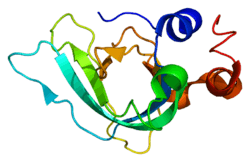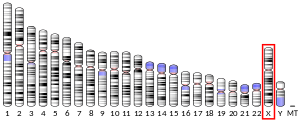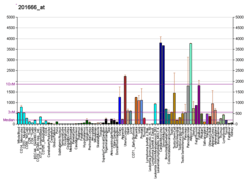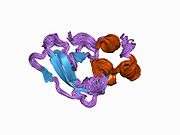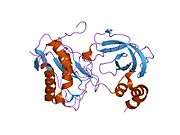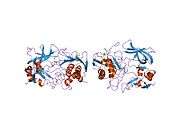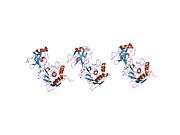TIMP1
TIMP metallopeptidase inhibitor 1, also known as TIMP1, a tissue inhibitor of metalloproteinases, is a glycoprotein that is expressed from the several tissues of organisms.
This protein is a member of the TIMP family. The glycoprotein is a natural inhibitor of the matrix metalloproteinases (MMPs), a group of peptidases involved in degradation of the extracellular matrix. In addition to its inhibitory role against most of the known MMPs, the encoded protein is able to promote cell proliferation in a wide range of cell types, and may also have an anti-apoptotic function.
Function
TIMP1 is an inhibitory molecule that regulates matrix metalloproteinases (MMPs), and disintegrin-metalloproteinases (ADAMs and ADAMTSs).[5] In regulating MMPs, TIMP1 plays a crucial role in extracellular matrix (ECM) composition, wound healing,[6] and pregnancy.[7][8][9]
The dysregulated activity of TIMP1 has been implicated in cancer.[10] In pregnancy, TIMP1 plays a regulatory role in the process of implantation, particularly the cytotrophoblast invasion of the uterine endometrium.[11] Additionally, it plays a role in regulating the transcriptional profile of fetal and placental tissues associated with the early stages of pregnancy.[12] Studies attribute this role to a mechanism involving the chromatin structure at the TIMP1 promoter region, implicating new pharmaceutical possibilities for the therapeutic regulation of TIMP1. Accordingly, TIMP1 can be manipulated in vitro using techniques, like the TIMP1 knock-out.[13][14][15]
Other names
- Erythroid potentiating activity (EPA)
- Human collagenase inhibitor (HCI)
Regulation of TIMP expression
Transcription of this gene is highly inducible in response to many cytokines and hormones. In addition, the expression from some but not all inactive X chromosomes suggests that this gene inactivation is polymorphic in human females. This gene is located within intron 6 of the synapsin I gene and is transcribed in the opposite direction.[16]
In adrenocortical cells the trophic hormone ACTH induces expression of TIMP-1 and the increase in TIMP expression is also associated with decreased collagenase activity.[17]
Increased expression of TIMP1 has been found to be associated with worse prognosis of various tumors, such as laryngeal carcinoma [18] or melanoma.[19]
References
- GRCh38: Ensembl release 89: ENSG00000102265 - Ensembl, May 2017
- GRCm38: Ensembl release 89: ENSMUSG00000001131 - Ensembl, May 2017
- "Human PubMed Reference:". National Center for Biotechnology Information, U.S. National Library of Medicine.
- "Mouse PubMed Reference:". National Center for Biotechnology Information, U.S. National Library of Medicine.
- Brew K, Nagase H (January 2010). "The tissue inhibitors of metalloproteinases (TIMPs): an ancient family with structural and functional diversity". Biochimica et Biophysica Acta (BBA) - Molecular Cell Research. 1803 (1): 55–71. doi:10.1016/j.bbamcr.2010.01.003. PMC 2853873. PMID 20080133.
- Brew K, Dinakarpandian D, Nagase H (March 2000). "Tissue inhibitors of metalloproteinases: evolution, structure and function". Biochimica et Biophysica Acta (BBA) - Protein Structure and Molecular Enzymology. 1477 (1–2): 267–83. doi:10.1016/S0167-4838(99)00279-4. PMID 10708863.
- Graham CH, Lala PK (August 1991). "Mechanism of control of trophoblast invasion in situ". Journal of Cellular Physiology. 148 (2): 228–34. doi:10.1002/jcp.1041480207. PMID 1652588.
- Nothnick WB, Soloway P, Curry TE (May 1997). "Assessment of the role of tissue inhibitor of metalloproteinase-1 (TIMP-1) during the periovulatory period in female mice lacking a functional TIMP-1 gene". Biology of Reproduction. 56 (5): 1181–8. doi:10.1095/biolreprod56.5.1181. PMID 9160717.
- Nothnick WB (September 2000). "Disruption of the tissue inhibitor of metalloproteinase-1 gene results in altered reproductive cyclicity and uterine morphology in reproductive-age female mice". Biology of Reproduction. 63 (3): 905–12. doi:10.1095/biolreprod63.3.905. PMID 10952938.
- Kim YS, Kim SH, Kang JG, Ko JH (2012). "Expression level and glycan dynamics determine the net effects of TIMP-1 on cancer progression". BMB Reports. 45 (11): 623–8. doi:10.5483/BMBRep.2012.45.11.233. PMC 4133808. PMID 23187000.
- Graham CH, Lala PK (August 1991). "Mechanism of control of trophoblast invasion in situ". Journal of Cellular Physiology. 148 (2): 228–34. doi:10.1002/jcp.1041480207. PMID 1652588.
- Vincent ZL, Mitchell MD, Ponnampalam AP (December 2015). "Regulation of TIMP-1 in Human Placenta and Fetal Membranes by lipopolysaccharide and demethylating agent 5-aza-2'-deoxycytidine". Reproductive Biology and Endocrinology. 13: 136. doi:10.1186/s12958-015-0132-y. PMC 4687108. PMID 26691525.
- Gong Y, Scott E, Lu R, Xu Y, Oh WK, Yu Q (2013-10-15). "TIMP-1 promotes accumulation of cancer associated fibroblasts and cancer progression". PLOS ONE. 8 (10): e77366. doi:10.1371/journal.pone.0077366. PMC 3797040. PMID 24143225.
- Jourquin J, Tremblay E, Bernard A, Charton G, Chaillan FA, Marchetti E, Roman FS, Soloway PD, Dive V, Yiotakis A, Khrestchatisky M, Rivera S (November 2005). "Tissue inhibitor of metalloproteinases-1 (TIMP-1) modulates neuronal death, axonal plasticity, and learning and memory". The European Journal of Neuroscience. 22 (10): 2569–78. doi:10.1111/j.1460-9568.2005.04426.x. PMID 16307599.
- Graham CH, Lala PK (August 1991). "Mechanism of control of trophoblast invasion in situ". Journal of Cellular Physiology. 148 (2): 228–34. doi:10.1002/jcp.1041480207. PMID 1652588.
- "Entrez Gene: TIMP1 TIMP metallopeptidase inhibitor 1".
- Reichenstein M, Reich R, LeHoux JG, Hanukoglu I (February 2004). "ACTH induces TIMP-1 expression and inhibits collagenase in adrenal cortex cells". Molecular and Cellular Endocrinology. 215 (1–2): 109–14. CiteSeerX 10.1.1.538.7614. doi:10.1016/j.mce.2003.11.011. PMID 15026182.
- Ma J, Wang J, Fan W, Pu X, Zhang D, Fan C, Xiong L, Zhu H, Xu N, Chen R, Liu S (Dec 2013). "Upregulated TIMP-1 correlates with poor prognosis of laryngeal squamous cell carcinoma". International Journal of Clinical and Experimental Pathology. 7 (1): 246–54. PMC 3885479. PMID 24427345.
- Tarhini AA, Lin Y, Yeku O, LaFramboise WA, Ashraf M, Sander C, Lee S, Kirkwood JM (January 2014). "A four-marker signature of TNF-RII, TGF-α, TIMP-1 and CRP is prognostic of worse survival in high-risk surgically resected melanoma". Journal of Translational Medicine. 12: 19. doi:10.1186/1479-5876-12-19. PMC 3909384. PMID 24457057.
Further reading
- Hornebeck W (December 2003). "Down-regulation of tissue inhibitor of matrix metalloprotease-1 (TIMP-1) in aged human skin contributes to matrix degradation and impaired cell growth and survival". Pathologie-Biologie. 51 (10): 569–73. doi:10.1016/j.patbio.2003.09.003. PMID 14622947.
- Gardner J, Ghorpade A (December 2003). "Tissue inhibitor of metalloproteinase (TIMP)-1: the TIMPed balance of matrix metalloproteinases in the central nervous system". Journal of Neuroscience Research. 74 (6): 801–6. doi:10.1002/jnr.10835. PMC 3857704. PMID 14648584.
External links
- The MEROPS online database for peptidases and their inhibitors: I35.001
- Overview of all the structural information available in the PDB for UniProt: P01033 (Metalloproteinase inhibitor 1) at the PDBe-KB.
